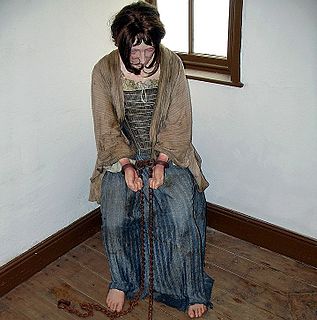 W
WPhysical restraint refers to means of purposely limiting or obstructing the freedom of a person's bodily movement.
 W
WAn armbinder is a type of restraint devices primarily used in bondage play, designed to bind the arms and/or hands to each other or to the body, usually behind the back, and employing a range of bondage equipment including cuffs, rods, straps, and gloves.
 W
WA ball and chain was a physical restraint device historically applied to prisoners, primarily in the British Empire and its former colonies, from the 17th century until as late as the mid-20th century. A type of shackle, the ball and chain is designed so that the weight of the iron ball at the end of the short chain restricts and limits the pace at which its wearer is able to move, making any attempt at escape much more difficult.
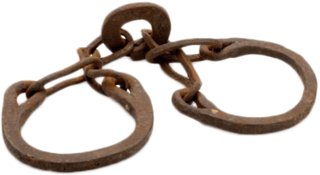 W
WBilboes or grillos are iron restraints normally placed on a person's ankles. They have commonly been used as leg shackles to restrain prisoners for different purposes until the modern ages. Bilboes were also used on slave ships, such as the Henrietta Marie. According to legend, the device was invented in Bilbao, Basque Country within Spain, and was imported into England by the ships of the Spanish Armada for use on prospective English prisoners. However, the Oxford English Dictionary notes that the term was used in English well before then.
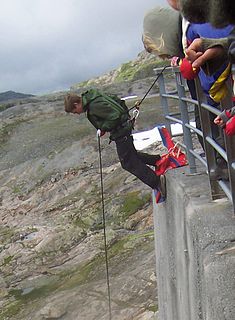 W
WA body belt is any waist belt which has D-rings or other attachment points. The belts can be used as medical restraints in institutions for bed and wheelchair restraints, and for safety in activities such as abseiling or construction work. When they are used in sexual bondage plays they are commonly referred to as bondage belts, and also worn in fetish clothing. The belts are usually fastened with buckles and some by a locking mechanism, which enables quick release.
 W
WBondage cuffs are restraints designed for use in sexual bondage situations. Compared to conventional handcuffs, they are wide wrist and ankle restraints generally made of leather, often padded with soft leather or fake fur. Bondage cuffs may be fastened at the wrists and/or ankles by a locking mechanism, by a buckle or by velcro. They are secured around the wrist or ankle, and the cuffs may then be attached to each other or another object.
 W
WBondage tape is a 2-to-3-inch-wide and 0.0051 in-thick (0.13-millimetre) strip of thin plastic material that adheres only to itself, without any adhesive; it is typically intended to be used in erotic bondage. Since it does not stick to the hair or skin, a bottom can be tightly bound or gagged without causing harm when the tape is removed.
 W
WA cage bed, also known as enclosure bed or veil bed, is a bed with either metal bars or netting designed to restrain a person of any given age within the boundaries of the bed. They are most commonly used with the mentally impaired or demented patients who are likely to get out of bed without warning.
 W
WA cangue or tcha is a device that was used for public humiliation and corporal punishment in East Asia and some other parts of Southeast Asia until the early years of the twentieth century. It was also occasionally used for or during torture. Because it restricted a person's movements, it was common for people wearing cangues to starve to death as they were unable to feed themselves.
 W
WA chastity belt is a locking item of clothing designed to prevent sexual intercourse or masturbation. Such belts were historically designed for women, ostensibly for the purpose of chastity, to protect women from rape or to dissuade women and their potential sexual partners from sexual temptation. Modern versions of the chastity belt are predominantly, but not exclusively, used in the BDSM community, and chastity belts are now designed for male wearers in addition to female wearers.
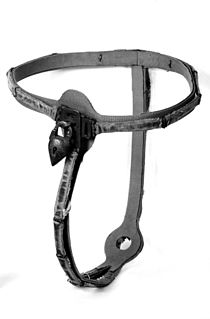 W
WChastity belts in BDSM may be used as part of a practice of orgasm control, to prevent the wearer from engaging principally in sexual intercourse without the permission of the dominant, who acts as "keyholder". A chastity belt will also prevent other sexual activity such as masturbation and oral sex involving the wearer's genitals. Chastity belts may be worn by both men and women as part of BDSM play. A chastity belt may be worn for the duration of a sex play, for a limited period or as a long-term arrangement.
 W
WA chemise cagoule was a heavy nightshirt worn by pious Catholic men and women during the Middle Ages in order to permit a husband to impregnate his wife without having to endure any unnecessary physical contact with her. The chemise cagoule covered all sexual areas, but left an opening for necessary contact. Pious couples were expected to use chemise cagoules at every lovemaking session, and thus would never see each other naked.
 W
WA drunkard's cloak was a type of pillory used in various jurisdictions to punish miscreants.
 W
WEscapology is the practice of escaping from restraints or other traps. Escapologists escape from handcuffs, straitjackets, cages, coffins, steel boxes, barrels, bags, burning buildings, fish-tanks, and other perils, often in combination.
 W
WA finger pillory is a style of restraint where the fingers are held in a wooden block, using an L-shaped hole to keep the knuckle bent inside the block. The name is taken from the pillory, a much larger device used to secure the head and hands.
 W
WA gag is usually an item or device designed to prevent speech, often as a restraint device to stop the subject from calling for help and keep its wearer quiet. This is usually done by blocking the mouth, partially or completely, or attempting to prevent the tongue, lips, or jaw from moving in the normal patterns of speech. The more "effective" a gag appears to be, the more hazardous it is: for example, duct tape is fairly effective at keeping one's mouth shut but is hazardous if for some reason the subject cannot breathe freely through the nose. For this reason, a gagged person should never be left alone.
 W
WA gag is a device used in sexual bondage and BDSM roleplay. Gags are usually associated with roleplays involving bondage, but that is not necessarily the case. The person who wears the gag is regarded as the submissive partner, while the other is regarded as the dominant one.
 W
WA handcuff cover is a piece of plastic or metal that can be placed around a pair of handcuffs. It consists of a hinged, box-like assembly locked over the handcuff chain, wristlets and keyholes.
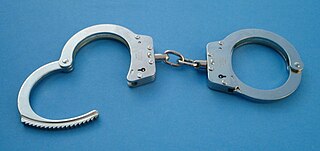 W
WHandcuffs are restraint devices designed to secure an individual's wrists in proximity to each other. They comprise two parts, linked together by a chain, a hinge, or rigid bar. Each cuff has a rotating arm which engages with a ratchet that prevents it from being opened once closed around a person's wrist. Without the key, the handcuffs cannot be removed without specialist knowledge, and the handcuffed person cannot move his or her wrists more than a few centimetres or inches apart, making many tasks difficult or impossible.
 W
WSpeedcuffs are a model of handcuff characterised by their rigid grip between the two ratchet cuffs. Their rigid design and the inclusion of a grip makes them effective for gaining control over a struggling prisoner, even if only one cuff has been applied. They were standard issue for most police forces within the United Kingdom.
 W
WA hobble, or spancel, is a device which prevents or limits the locomotion of an animal, by tethering one or more legs. Although hobbles are most commonly used on horses, they are also sometimes used on other animals. On dogs, they are used especially during force-fetch training to limit the movement of a dog's front paws when training it to stay still. They are made from leather, rope, or synthetic materials such as nylon or neoprene. There are various designs for breeding, casting, and mounting horses.
 W
WThe hogtie is a method of tying the limbs together, rendering the subject immobile and helpless. Originally, it was applied to pigs and other young four-legged animals.
 W
WHojōjutsu or Torinawajutsu or just Nawajutsu , is the traditional Japanese martial art of restraining a person using cord or rope, as a precursor to modern-day handcuffs. Encompassing many different materials, techniques and methods from many different schools, Hojōjutsu is a quintessentially Japanese art that is a unique product of Japanese history and culture.
 W
WThe jougs, juggs, or joggs is a metal collar formerly used as an instrument of punishment in Scotland, the Netherlands and other countries.
 W
WThe jugum penis or pollutions ring was an anti-masturbatory device developed in the 18th century. It consisted of a steel clip with serrated teeth that could be attached to the penis to deter its unwanted erection. It is one of many devices from the 1700s designed to prevent masturbation and to cure what was then claimed to be an illness called spermatorrhoea.
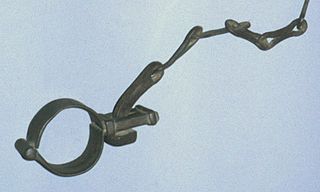 W
WLegcuffs are physical restraints used on the ankles of a person to allow walking only with a restricted stride and to prevent running and effective physical resistance.
 W
WLimb restraints are physical restraints that are applied to a person's arms or legs. They are used as medical restraints.
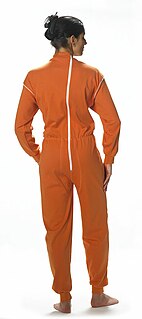 W
WLocking clothing are garments.
 W
WMedical restraints are physical restraints used during certain medical procedures to restrain patients with the minimum of discomfort and pain and to prevent them from injuring themselves or others.
 W
WA nose hook is a pair of small blunt hooks on the end of a strap. One hook is fitted to each nostril and when pulled on upwards, the device can be used to force a person's head back. It is sometimes used in BDSM or bondage play, especially in Japan.
 W
WThe pillory is a device made of a wooden or metal framework erected on a post, with holes for securing the head and hands, formerly used for punishment by public humiliation and often further physical abuse. The pillory is related to the stocks.
 W
WPlastic handcuffs are a form of physical restraint for the hands, using plastic straps. They function as handcuffs but are cheaper and easier to carry than metal handcuffs, and they cannot be reused. The device was first introduced in 1965.
 W
WA posture collar is a rigid collar used in BDSM and fetish play that is wide enough to restrict movement of the neck. Posture collars help in maintaining posture, keeping the chin high and the neck extended. Posture collars typically flare widely at the front to reach from the chin to the collarbone, preventing the wearer from hanging their head or looking downward.
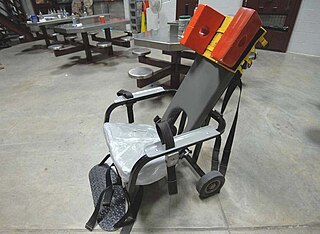 W
WA restraint chair is a type of physical restraint that is used to force an individual to remain seated in one place to prevent injury and harm to themselves or others. They are commonly used in prisons for violent inmates and hospitals for out of control patients. However, they have also been used to restrain prisoners at Guantanamo Bay detention camp during force-feeding.
 W
WA Schandmantel or Schandtonne, sometimes also Spanish coat, is a torture device which came into use in the 13th century. Schandmantels were fashioned from wood and sometimes lined with sheet metal. Victims were made to wear this device in public where they would be insulted, humiliated and have rotten vegetables thrown at them. The Schandmantel was mostly used as punishment for poachers and prostitutes.
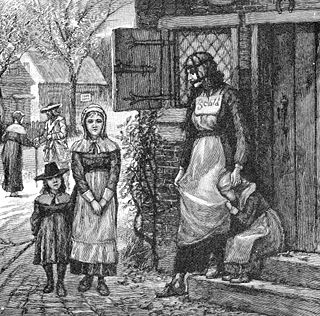 W
WA scold's bridle, sometimes called a witch's bridle, a brank's bridle, or simply branks, was an instrument of punishment, as a form of torture and public humiliation. The device was an iron muzzle in an iron framework that enclosed the head. A bridle-bit, about 2 in × 1 in in size, was slid into the mouth and either pressed down on top of the tongue as a compress or used to raise the tongue to lie flat on the wearer's palate. This prevented speaking and resulted in many unpleasant side effects for the wearer, including excessive salivation and fatigue in the mouth.
 W
WSelf-bondage refers to the use of restraints on oneself for erotic pleasure. It is a form of erotic bondage which can be practiced alone.
 W
WA shrew's fiddle or neck violin is a variation of the yoke, pillory or rigid irons whereby the wrists are locked in front of the bound person by a hinged board or steel bar. It was originally used in the Middle Ages as a way of punishing those who were caught bickering or fighting.
 W
WThe spread eagle is the position in which a person has their arms outstretched and legs apart, figuratively resembling an eagle with wings spread. It is a style that appears commonly in nature and geometry. In human style it is represented by the letter "X".
 W
WA spreader bar is an article of bondage equipment consisting of a metal or wooden bar, with attachment points for bondage cuffs at each end, which can be fastened to wrists, ankles or knees to hold them apart. They are used in bondage play, and sometimes in bedroom bondage, usually in association with other bondage equipment.
 W
WStocks are restraining devices that were used as a form of corporal punishment and public humiliation.
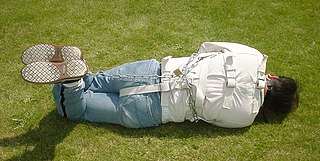 W
WA straitjacket is a garment shaped like a jacket with long sleeves that surpass the tips of the wearer's fingers. Its most typical use is restraining people who may cause harm to themselves or others. Once the wearer slides their arms into the sleeves, the person assisting the wearer crosses the sleeves against the chest and ties the ends of the sleeves to the back of the jacket, ensuring the arms are close to the chest with as little movement as possible.
 W
WSuspension bondage is a form of sexual bondage where a bound person is hung from one or more overhead suspension points. Suspension bondage carries a higher risk than other forms of sexual bondage.
 W
WSwaddling is an age-old practice of wrapping infants in blankets or similar cloths so that movement of the limbs is tightly restricted. Swaddling bands were often used to further restrict the infant. Swaddling fell out of favor in the 17th century.
 W
WThumbcuffs are a metal restraining device that lock thumbs in proximity to each other.
 W
WA vacuum bed is a device sometimes used in BDSM play.
 W
WThe X-cross, X-frame or saltire cross is a common piece of equipment in BDSM dungeons. It typically provides restraining points for ankles, wrists, and waist. When secured to a saltire, the subject is restrained in a spreadeagle position.